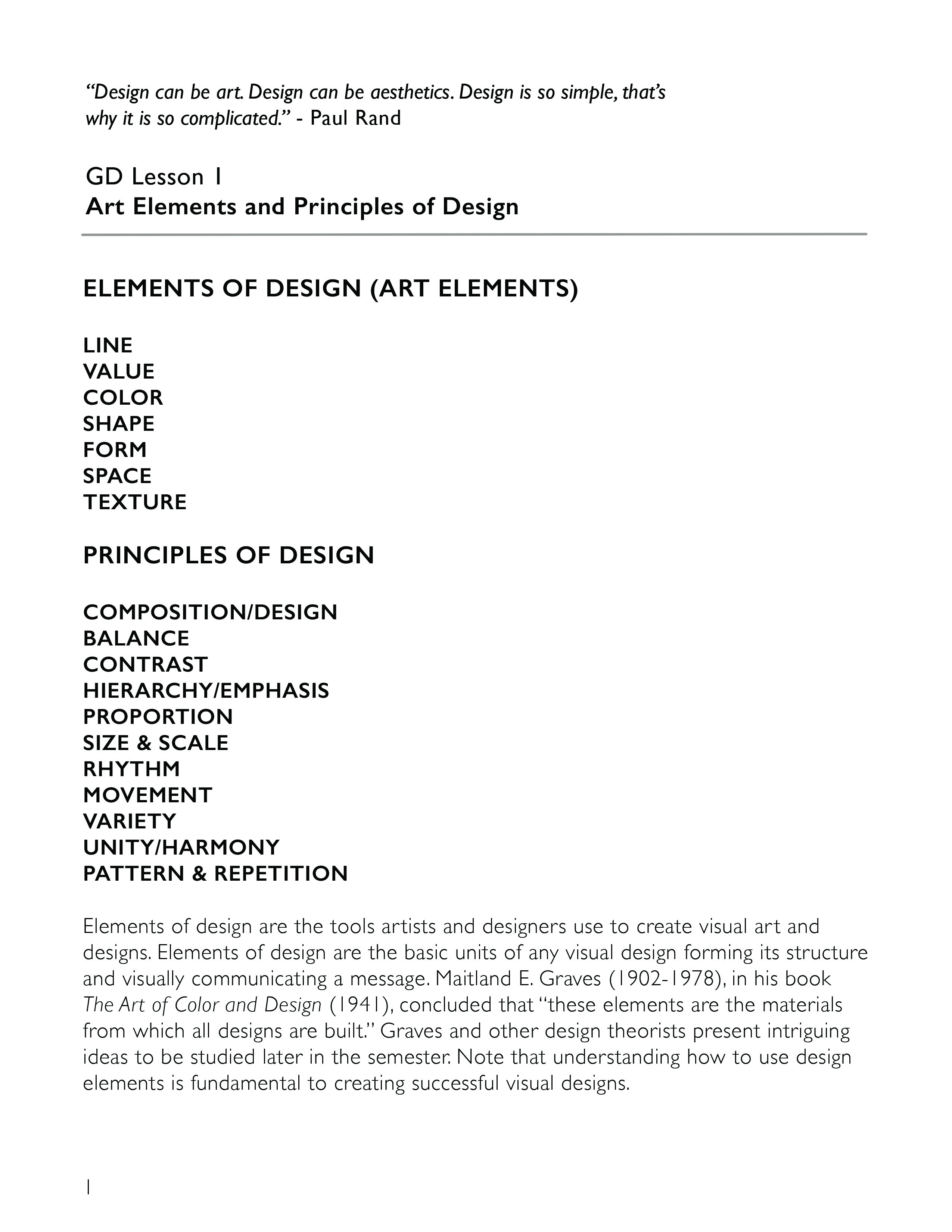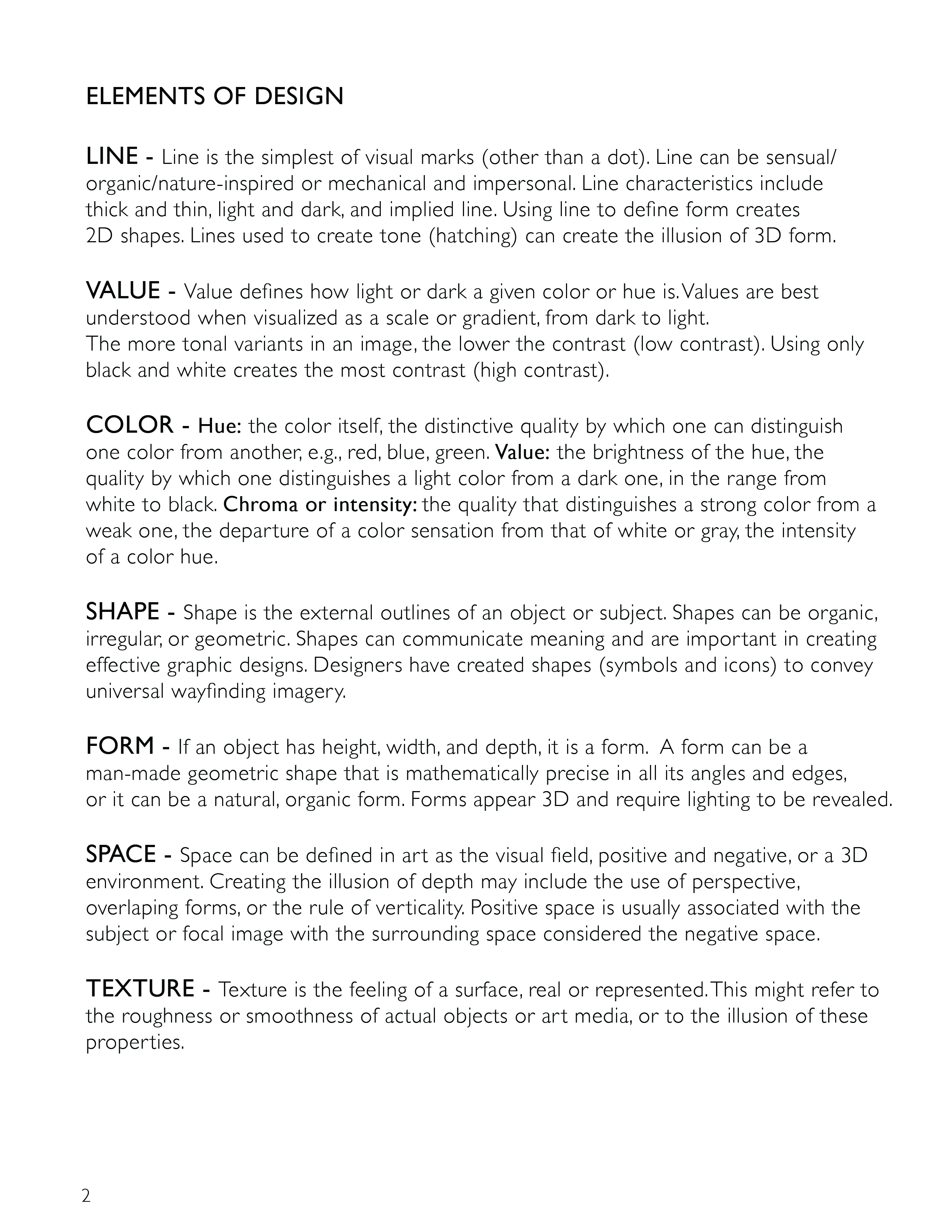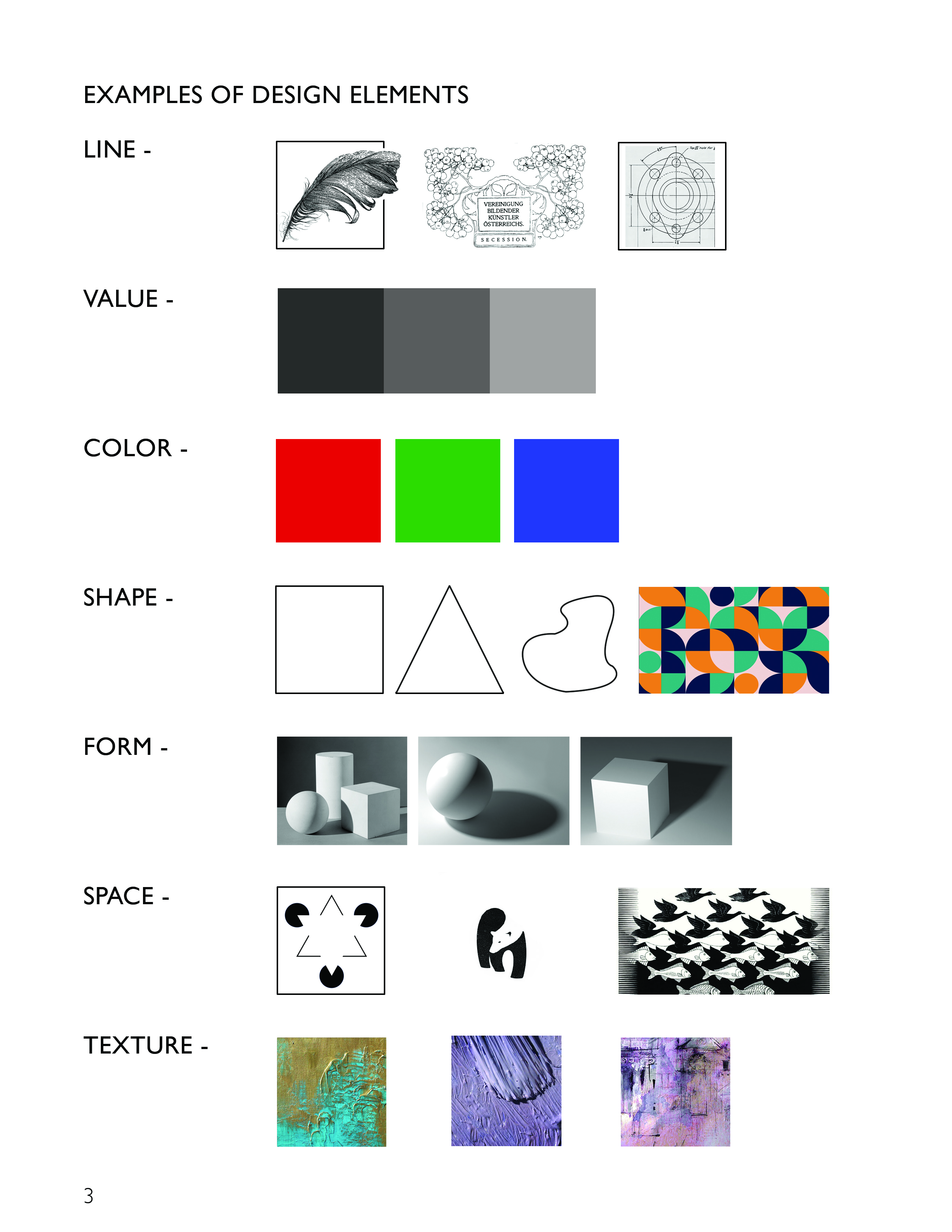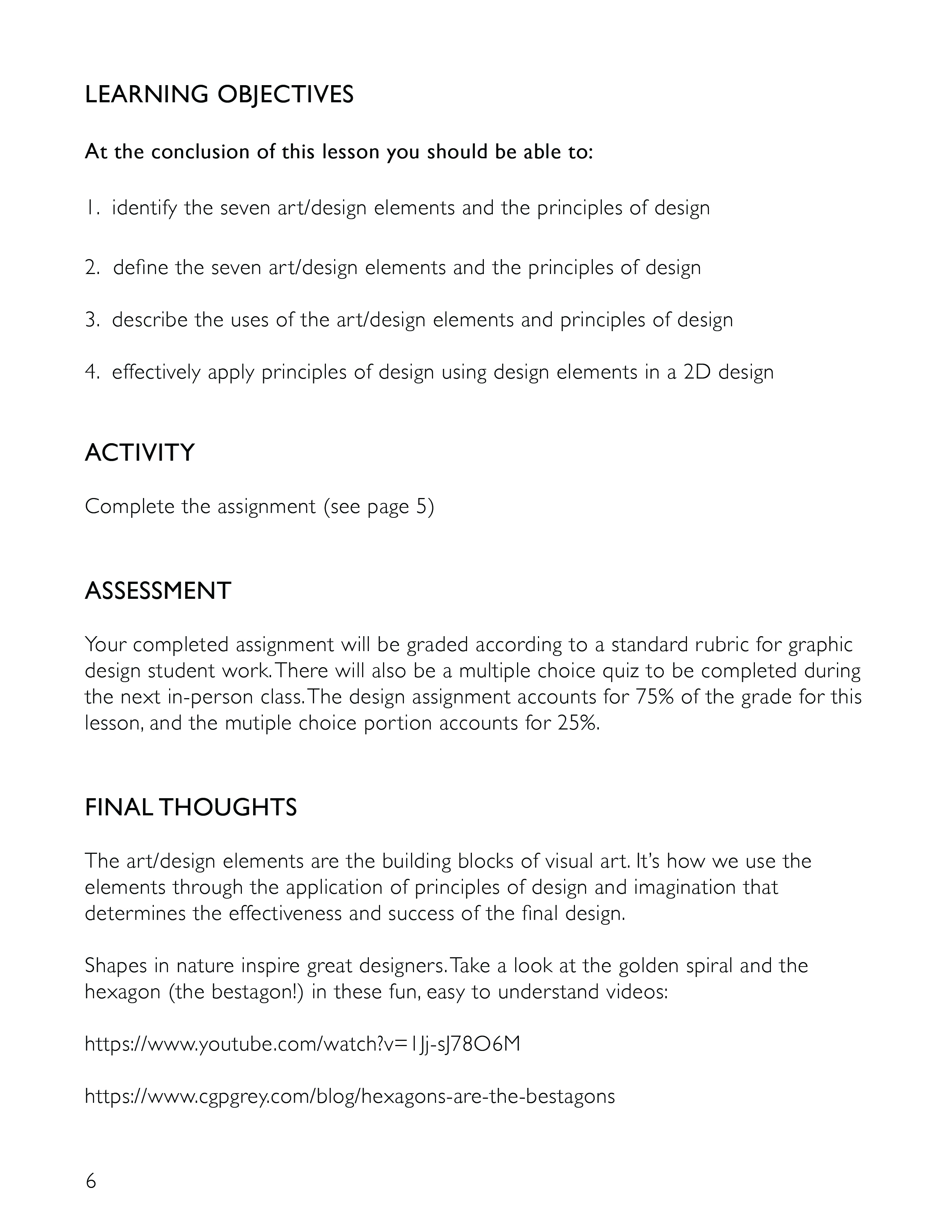2: Art Elements and Principles of Design
- Page ID
- 122816
\( \newcommand{\vecs}[1]{\overset { \scriptstyle \rightharpoonup} {\mathbf{#1}} } \)
\( \newcommand{\vecd}[1]{\overset{-\!-\!\rightharpoonup}{\vphantom{a}\smash {#1}}} \)
\( \newcommand{\id}{\mathrm{id}}\) \( \newcommand{\Span}{\mathrm{span}}\)
( \newcommand{\kernel}{\mathrm{null}\,}\) \( \newcommand{\range}{\mathrm{range}\,}\)
\( \newcommand{\RealPart}{\mathrm{Re}}\) \( \newcommand{\ImaginaryPart}{\mathrm{Im}}\)
\( \newcommand{\Argument}{\mathrm{Arg}}\) \( \newcommand{\norm}[1]{\| #1 \|}\)
\( \newcommand{\inner}[2]{\langle #1, #2 \rangle}\)
\( \newcommand{\Span}{\mathrm{span}}\)
\( \newcommand{\id}{\mathrm{id}}\)
\( \newcommand{\Span}{\mathrm{span}}\)
\( \newcommand{\kernel}{\mathrm{null}\,}\)
\( \newcommand{\range}{\mathrm{range}\,}\)
\( \newcommand{\RealPart}{\mathrm{Re}}\)
\( \newcommand{\ImaginaryPart}{\mathrm{Im}}\)
\( \newcommand{\Argument}{\mathrm{Arg}}\)
\( \newcommand{\norm}[1]{\| #1 \|}\)
\( \newcommand{\inner}[2]{\langle #1, #2 \rangle}\)
\( \newcommand{\Span}{\mathrm{span}}\) \( \newcommand{\AA}{\unicode[.8,0]{x212B}}\)
\( \newcommand{\vectorA}[1]{\vec{#1}} % arrow\)
\( \newcommand{\vectorAt}[1]{\vec{\text{#1}}} % arrow\)
\( \newcommand{\vectorB}[1]{\overset { \scriptstyle \rightharpoonup} {\mathbf{#1}} } \)
\( \newcommand{\vectorC}[1]{\textbf{#1}} \)
\( \newcommand{\vectorD}[1]{\overrightarrow{#1}} \)
\( \newcommand{\vectorDt}[1]{\overrightarrow{\text{#1}}} \)
\( \newcommand{\vectE}[1]{\overset{-\!-\!\rightharpoonup}{\vphantom{a}\smash{\mathbf {#1}}}} \)
\( \newcommand{\vecs}[1]{\overset { \scriptstyle \rightharpoonup} {\mathbf{#1}} } \)
\( \newcommand{\vecd}[1]{\overset{-\!-\!\rightharpoonup}{\vphantom{a}\smash {#1}}} \)
\(\newcommand{\avec}{\mathbf a}\) \(\newcommand{\bvec}{\mathbf b}\) \(\newcommand{\cvec}{\mathbf c}\) \(\newcommand{\dvec}{\mathbf d}\) \(\newcommand{\dtil}{\widetilde{\mathbf d}}\) \(\newcommand{\evec}{\mathbf e}\) \(\newcommand{\fvec}{\mathbf f}\) \(\newcommand{\nvec}{\mathbf n}\) \(\newcommand{\pvec}{\mathbf p}\) \(\newcommand{\qvec}{\mathbf q}\) \(\newcommand{\svec}{\mathbf s}\) \(\newcommand{\tvec}{\mathbf t}\) \(\newcommand{\uvec}{\mathbf u}\) \(\newcommand{\vvec}{\mathbf v}\) \(\newcommand{\wvec}{\mathbf w}\) \(\newcommand{\xvec}{\mathbf x}\) \(\newcommand{\yvec}{\mathbf y}\) \(\newcommand{\zvec}{\mathbf z}\) \(\newcommand{\rvec}{\mathbf r}\) \(\newcommand{\mvec}{\mathbf m}\) \(\newcommand{\zerovec}{\mathbf 0}\) \(\newcommand{\onevec}{\mathbf 1}\) \(\newcommand{\real}{\mathbb R}\) \(\newcommand{\twovec}[2]{\left[\begin{array}{r}#1 \\ #2 \end{array}\right]}\) \(\newcommand{\ctwovec}[2]{\left[\begin{array}{c}#1 \\ #2 \end{array}\right]}\) \(\newcommand{\threevec}[3]{\left[\begin{array}{r}#1 \\ #2 \\ #3 \end{array}\right]}\) \(\newcommand{\cthreevec}[3]{\left[\begin{array}{c}#1 \\ #2 \\ #3 \end{array}\right]}\) \(\newcommand{\fourvec}[4]{\left[\begin{array}{r}#1 \\ #2 \\ #3 \\ #4 \end{array}\right]}\) \(\newcommand{\cfourvec}[4]{\left[\begin{array}{c}#1 \\ #2 \\ #3 \\ #4 \end{array}\right]}\) \(\newcommand{\fivevec}[5]{\left[\begin{array}{r}#1 \\ #2 \\ #3 \\ #4 \\ #5 \\ \end{array}\right]}\) \(\newcommand{\cfivevec}[5]{\left[\begin{array}{c}#1 \\ #2 \\ #3 \\ #4 \\ #5 \\ \end{array}\right]}\) \(\newcommand{\mattwo}[4]{\left[\begin{array}{rr}#1 \amp #2 \\ #3 \amp #4 \\ \end{array}\right]}\) \(\newcommand{\laspan}[1]{\text{Span}\{#1\}}\) \(\newcommand{\bcal}{\cal B}\) \(\newcommand{\ccal}{\cal C}\) \(\newcommand{\scal}{\cal S}\) \(\newcommand{\wcal}{\cal W}\) \(\newcommand{\ecal}{\cal E}\) \(\newcommand{\coords}[2]{\left\{#1\right\}_{#2}}\) \(\newcommand{\gray}[1]{\color{gray}{#1}}\) \(\newcommand{\lgray}[1]{\color{lightgray}{#1}}\) \(\newcommand{\rank}{\operatorname{rank}}\) \(\newcommand{\row}{\text{Row}}\) \(\newcommand{\col}{\text{Col}}\) \(\renewcommand{\row}{\text{Row}}\) \(\newcommand{\nul}{\text{Nul}}\) \(\newcommand{\var}{\text{Var}}\) \(\newcommand{\corr}{\text{corr}}\) \(\newcommand{\len}[1]{\left|#1\right|}\) \(\newcommand{\bbar}{\overline{\bvec}}\) \(\newcommand{\bhat}{\widehat{\bvec}}\) \(\newcommand{\bperp}{\bvec^\perp}\) \(\newcommand{\xhat}{\widehat{\xvec}}\) \(\newcommand{\vhat}{\widehat{\vvec}}\) \(\newcommand{\uhat}{\widehat{\uvec}}\) \(\newcommand{\what}{\widehat{\wvec}}\) \(\newcommand{\Sighat}{\widehat{\Sigma}}\) \(\newcommand{\lt}{<}\) \(\newcommand{\gt}{>}\) \(\newcommand{\amp}{&}\) \(\definecolor{fillinmathshade}{gray}{0.9}\)Discussion:
The generally recognized seven art elements include 1. Line, 2. Value, 3. Color, 4. Texture, 5. Form, 6. Shape, and 7. Space. These are the building blocks of art and the tools with which artists create. The Principles of Design are also used along with Art Elements in the creation of successful works of art in both three-dimensions and two-dimensions. The Principles of Design are more expansive and include the following: Composition (for drawing and painting), Perspective (both linear and isometric), Balance (both symmetrical and asymmetrical), Repetition, Pattern, Size and Scale, Unity, Variety, Movement, Proportion, Emphasis, Hierarchy, Contrast, Rhythm, and Harmony.


Art Elements
Line:
The simplest mark we can make in art is a dot. If we theoretically extend that dot along a path we create a line. The line we create may have characteristics suggesting an organic form or a mechanical, man-made form. The line may enclose a space, or create a symbol such as a letter in an alphabet. Line, although an abstract construct, has the ability to visually communicate in a variety of ways. It is often the starting point when learning to draw. It is essential to understand the many characteristics of line when studying two-dimensional design.

The organic/sensual line can be quite expressive with the use of contrast in thickness, length, and values. A great place to study this type of expressive line is in the curvilinear lines of Art Nouveau. Art Nouveau (or new art) was very popular from 1890-1910. One of the major influential artists of the period who is often credited with pushing this art style forward is Alphonse Mucha.
https://en.Wikipedia.org/wiki/Alphonse_Mucha
https://www.youtube.com/watch?v=CYWOkvKuXvk
https://www.youtube.com/watch?v=vd8mxgPYx7g
https://personal.utdallas.edu/~melac...ticsofLine.pdf
https://slideplayer.com/slide/14844394/
https://thevirtualinstructor.com/line.html
Characteristics of the sensual organic line include the use of thick and thin, implied line (lose and find the line), and light and dark values.
The mechanical or impersonal line works well for man-made objects are for clean, abstract compositions.
Tone:
We see the world in three-dimensions. Forms and shapes are defined by the amount and quality of available light. When there is ample light, there may be many identifiable tones on visible forms. However, if you imagine an actor on a blacked out stage with one spotlight on him/her, the tones will be stark and in extreme contrast. Learning to draw or design with tone requires the ability to differentiate between values. Constructing a value scale by either drawing, painting, or gluing paper in a evenly stepped sequence of light to dark is a worthy exercise to develop the ability recognize value changes.
Basic characteristics of tone in art include the following: the quality of light will have an effect on the visible forms; adjacent values will have an effect on each value; reflected light onto an object will help create the illusion of roundness or three-dimensions;
Texture:
https://www.thoughtco.com/definition...-in-art-182468
Principles of Design
The principles of design include the many ways that artists use the art elements to create visual art. These principles include, but are not limited to, the following art concepts: Balance (both symmetrical and asymmetrical); unity, variety, pattern, repetition, ornament, rhythm, emphasis, subordination, hierarchy of forms, perspective (both linear and isometric), contrast, size and scale, proportion, design systems, depth, visual field, movement, and composition.
Let's consider similarities in colors, textures, and shapes. We often see these in nature, whether in animals or plants. If we cross dog breeds for example, the offspring quickly adopt features of both breeds so we see similarities. The same for our families. We may see our siblings having similar hair texture and color, skin color, or facial and or body features. We are all tied to our families genetically and it can be a beautiful thing!



https://www.youtube.com/watch?v=1Jj-sJ78O6M
https://www.cgpgrey.com/blog/hexagons-are-the-bestagons
Ornate Patterning

Patterns allow us to explore the deliberate repetition of specific shapes and colors. When this becomes an area of emphasis, even mathematics can come into play as in the incredible visuals in Islamic art.

Not only can there be a sublime beauty to the work, it can also be functional as in the carved stone designs at the muslim architectural landmark known as the Alhambra. The designs allow for air flow between spaces, are beautifully patterned, bring glory to God through the work of human hands according to Muslim beliefs, and are profoundly beautiful in their artistic visual details and intellectual design.
The Alhambra

